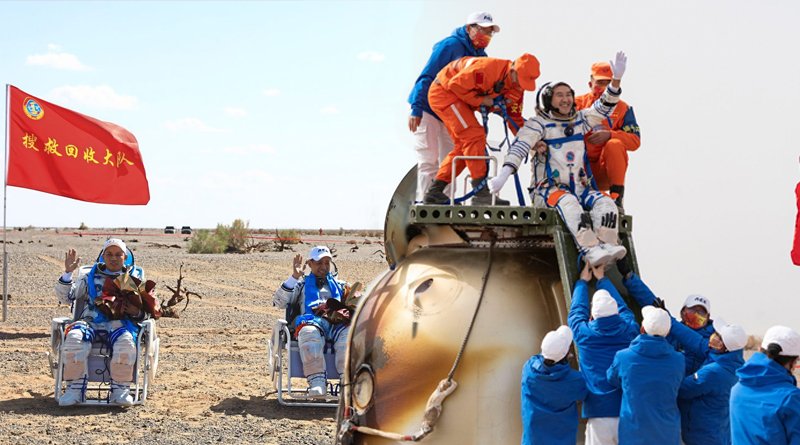Dongfeng Landing Site was put into practical use in September 2021, when it welcomed home the three astronauts of the Shenzhou-12 manned space mission.

Thanks to years of training and painstaking efforts, north China’s Dongfeng Landing Site has developed strong search and rescue capabilities to ensure the smooth running of an important link of the country’s manned space program, said a senior official of the site during an interview with China Media Group (CMG).
Located in the Gobi Desert in north China‘s Inner Mongolia Autonomous Region near Jiuquan Satellite Launch Center, Dongfeng Landing Site was put into practical use in September 2021, when it welcomed home the three astronauts of the Shenzhou-12 manned space mission.
“We have a mature search and rescue scheme. The Beijing Center and Dongfeng Center predict the landing point of the re-entry capsule in real time, and the air and ground detachments start off in advance to the predicted landing point,” said Hu Xiaochun, deputy director of Jiuquan Satellite Launch Center and deputy commander of the landing site headquarters of China’s manned space program.
Hu said that the night search for the Shenzhou-14 manned spacecraft in December 2022 was conducted smoothly.
“We ensured the arrival of helicopters and personnel as soon as the spacecraft landed. Each task, including landing, opening the latch and taking the astronauts out of the cabin, was carried out in an interconnected and orderly manner,” he said.
Previously, China’s returning spacecrafts used to land at a site in Siziwang Banner in Inner Mongolia, while Dongfeng served as a backup site to ensure the meteorological conditions at the landing site met the requirements for safe landing.
In December 2022, the Shenzhou-15 mission wrapped up the construction of China’s space station and started the first stage of its application and development. Now, spacecraft can remain docked at the space station until the meteorological conditions are proper for their return. There is no longer the need to set up a weather backup landing field.
Dongfeng Landing Site, with the support of powerful telemetry, communications, meteorology and medical resources of Jiuquan Satellite Launch Center, is a better choice for undertaking search and rescue missions.
“We have upgraded the vehicle and communication equipment on the aircraft in an all-round way to ensure smooth communication across the landing area. We have also customized a special vehicle for medical supervision and healthcare,” Hu said.
After the spacecraft descends into the Earth atmosphere, it can only rely on the ground telemetry stations. Spacecraft monitoring is completely covered by the northwest telemetry belt. The whole process of a spacecraft’s return is visible through live broadcast, including the moment of landing, which is recorded from multiple angles.
Hu said that the landing of the Shenzhou-12 manned spacecraft in September 2021 can be said to be a major test of Dongfeng Landing Site’s search and rescue plan, technical equipment and personnel.
In addition to the search and rescue missions, the team at the site also prepares for a possible emergency rescue during the mission launch.
“In the 582 seconds from ignition to entering orbit, the rocket undergoes many actions, such as engine ignition, separation of the first and second stages, and separation of the fairing. Even if only one of these actions goes wrong, the spacecraft cannot enter orbit.
In such a scenario, the emergency rescue team of our landing site system must be able to bring astronauts back safely from different locations,” said Hu.
In its most recent mission on December 4, 2022, the site accomplished China’s first search and rescue of a manned spaceship on a winter night as the three-member crew of the Shenzhou-14 manned space mission returned safely with a difference of some 200 meters between the actual and predicted landing points. Such a high accuracy required precise calculation and control, Hu explained.
“After our country’s BeiDou Navigation Satellite System was put into use, the forecast model of the entire re-entry process is getting more and more accurate. Meanwhile, the application of space-based telemetry provides more information sources for the prediction of the landing point,” he said.
Originally published at CGTN